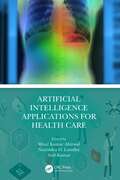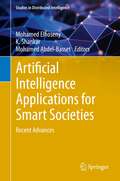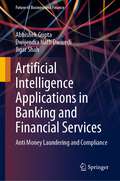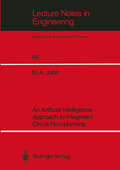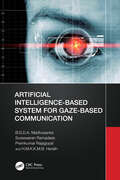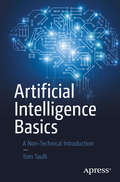- Table View
- List View
Artificial Intelligence Applications and Reconfigurable Architectures
by Sheetal Umesh Bhandari Anuradha D. ThakareARTIFICIAL INTELLIGENCE APPLICATIONS and RECONFIGURABLE ARCHITECTURES The primary goal of this book is to present the design, implementation, and performance issues of AI applications and the suitability of the FPGA platform. This book covers the features of modern Field Programmable Gate Arrays (FPGA) devices, design techniques, and successful implementations pertaining to AI applications. It describes various hardware options available for AI applications, key advantages of FPGAs, and contemporary FPGA ICs with software support. The focus is on exploiting parallelism offered by FPGA to meet heavy computation requirements of AI as complete hardware implementation or customized hardware accelerators. This is a comprehensive textbook on the subject covering a broad array of topics like technological platforms for the implementation of AI, capabilities of FPGA, suppliers’ software tools and hardware boards, and discussion of implementations done by researchers to encourage the AI community to use and experiment with FPGA. Readers will benefit from reading this book because It serves all levels of students and researcher’s as it deals with the basics and minute details of Ecosystem Development Requirements for Intelligent applications with reconfigurable architectures whereas current competitors’ books are more suitable for understanding only reconfigurable architectures. It focuses on all aspects of machine learning accelerators for the design and development of intelligent applications and not on a single perspective such as only on reconfigurable architectures for IoT applications. It is the best solution for researchers to understand how to design and develop various AI, deep learning, and machine learning applications on the FPGA platform. It is the best solution for all types of learners to get complete knowledge of why reconfigurable architectures are important for implementing AI-ML applications with heavy computations. Audience Researchers, industrial experts, scientists, and postgraduate students who are working in the fields of computer engineering, electronics, and electrical engineering, especially those specializing in VLSI and embedded systems, FPGA, artificial intelligence, Internet of Things, and related multidisciplinary projects.
Artificial Intelligence Applications and Reconfigurable Architectures
by Anuradha D. Thakare Sheetal Umesh BhandariARTIFICIAL INTELLIGENCE APPLICATIONS and RECONFIGURABLE ARCHITECTURES The primary goal of this book is to present the design, implementation, and performance issues of AI applications and the suitability of the FPGA platform. This book covers the features of modern Field Programmable Gate Arrays (FPGA) devices, design techniques, and successful implementations pertaining to AI applications. It describes various hardware options available for AI applications, key advantages of FPGAs, and contemporary FPGA ICs with software support. The focus is on exploiting parallelism offered by FPGA to meet heavy computation requirements of AI as complete hardware implementation or customized hardware accelerators. This is a comprehensive textbook on the subject covering a broad array of topics like technological platforms for the implementation of AI, capabilities of FPGA, suppliers’ software tools and hardware boards, and discussion of implementations done by researchers to encourage the AI community to use and experiment with FPGA. Readers will benefit from reading this book because It serves all levels of students and researcher’s as it deals with the basics and minute details of Ecosystem Development Requirements for Intelligent applications with reconfigurable architectures whereas current competitors’ books are more suitable for understanding only reconfigurable architectures. It focuses on all aspects of machine learning accelerators for the design and development of intelligent applications and not on a single perspective such as only on reconfigurable architectures for IoT applications. It is the best solution for researchers to understand how to design and develop various AI, deep learning, and machine learning applications on the FPGA platform. It is the best solution for all types of learners to get complete knowledge of why reconfigurable architectures are important for implementing AI-ML applications with heavy computations. Audience Researchers, industrial experts, scientists, and postgraduate students who are working in the fields of computer engineering, electronics, and electrical engineering, especially those specializing in VLSI and embedded systems, FPGA, artificial intelligence, Internet of Things, and related multidisciplinary projects.
Artificial Intelligence Applications for Health Care
by Mitul Kumar Ahirwal Narendra D. Londhe Anil KumarThis book takes an interdisciplinary approach by covering topics on health care and artificial intelligence. Data sets related to biomedical signals (ECG, EEG, EMG) and images (X-rays, MRI, CT) are explored, analyzed, and processed through different computation intelligence methods. Applications of computational intelligence techniques like artificial and deep neural networks, swarm optimization, expert systems, decision support systems, clustering, and classification techniques on medial datasets are explained. Survey of medical signals, medial images, and computation intelligence methods are also provided in this book. Key Features Covers computational Intelligence techniques like artificial neural networks, deep neural networks, and optimization algorithms for Healthcare systems Provides easy understanding for concepts like signal and image filtering techniques Includes discussion over data preprocessing and classification problems Details studies with medical signal (ECG, EEG, EMG) and image (X-ray, FMRI, CT) datasets Describes evolution parameters such as accuracy, precision, and recall etc. This book is aimed at researchers and graduate students in medical signal and image processing, machine and deep learning, and healthcare technologies.
Artificial Intelligence Applications for Health Care
by Mitul Kumar Ahirwal Narendra D. Londhe Anil KumarThis book takes an interdisciplinary approach by covering topics on health care and artificial intelligence. Data sets related to biomedical signals (ECG, EEG, EMG) and images (X-rays, MRI, CT) are explored, analyzed, and processed through different computation intelligence methods. Applications of computational intelligence techniques like artificial and deep neural networks, swarm optimization, expert systems, decision support systems, clustering, and classification techniques on medial datasets are explained. Survey of medical signals, medial images, and computation intelligence methods are also provided in this book. Key Features Covers computational Intelligence techniques like artificial neural networks, deep neural networks, and optimization algorithms for Healthcare systems Provides easy understanding for concepts like signal and image filtering techniques Includes discussion over data preprocessing and classification problems Details studies with medical signal (ECG, EEG, EMG) and image (X-ray, FMRI, CT) datasets Describes evolution parameters such as accuracy, precision, and recall etc. This book is aimed at researchers and graduate students in medical signal and image processing, machine and deep learning, and healthcare technologies.
Artificial Intelligence Applications for Smart Societies: Recent Advances (Studies in Distributed Intelligence)
by Mohamed Elhoseny K. Shankar Mohamed Abdel-BassetThis volume discusses recent advances in Artificial Intelligence (AI) applications in smart, internet-connected societies, highlighting three key focus areas. The first focus is on intelligent sensing applications. This section details the integration of Wireless Sensing Networks (WSN) and the use of intelligent platforms for WSN applications in urban infrastructures, and discusses AI techniques on hardware and software systems such as machine learning, pattern recognition, expert systems, neural networks, genetic algorithms, and intelligent control in transportation and communications systems. The second focus is on AI-based Internet of Things (IoT) systems, which addresses applications in traffic management, medical health, smart homes and energy. Readers will also learn about how AI can extract useful information from Big Data in IoT systems. The third focus is on crowdsourcing (CS) and computing for smart cities. this section discusses how CS via GPS devices, GIS tools, traffic cameras, smart cards, smart phones and road deceleration devices enables citizens to collect and share data to make cities smart, and how these data can be applied to address urban issues including pollution, traffic congestion, public safety and increased energy consumption. This book will of interest to academics, researchers and students studying AI, cloud computing, IoT and crowdsourcing in urban applications.
Artificial Intelligence Applications in a Pandemic: COVID-19 (Smart and Intelligent Computing in Engineering)
by Salah-Ddine KritCOVID-19, a novel coronavirus pandemic has disrupted our society in many ways. Digital healthcare innovations are required more than ever before as we come across myriad challenges during this pandemic. Scientists and developers are learning and finding a way to use artificial intelligence applications and natural language processing to comprehend and tackle this disease. AI technologies are playing an important role in the response to the COVID-19 pandemic. Experts are using all possible tools to study the virus, diagnose individuals, and analyze the public health impacts. This book is a collection of some of the leading efforts related to AI and COVID-19 focused on finding how AI can be helpful in monitoring the situation from early warnings, swift emergency responses, and critical decision-making. It discusses the use of machine learning and how it may help to reduce the impacts of this pandemic in conjunction with all other research and strategies going on. The book serves as a technical resource of data analytics and AI applications in tracking infectious diseases. It will serve academics, students, data scientists, medical practitioners, and anybody managing a global pandemic. Features: Directs the attention to the smart digital healthcare system in this COVID-19 pandemic. Simulates novel investigations and how they will be beneficial in understanding the pandemic. Presents the latest ideas developed for data scientists, doctors, engineers, and economists. Analyses the various issues related to computing, AI apps, big data analytic techniques, and predictive scientific skill gaps. Explains some interesting and diverse types of challenges and data-driven healthcare applications.
Artificial Intelligence Applications in a Pandemic: COVID-19 (Smart and Intelligent Computing in Engineering)
by Salah-Ddine Krit Vrijendra Singh Mohamed Elhoseny Yashbir SinghCOVID-19, a novel coronavirus pandemic has disrupted our society in many ways. Digital healthcare innovations are required more than ever before as we come across myriad challenges during this pandemic. Scientists and developers are learning and finding a way to use artificial intelligence applications and natural language processing to comprehend and tackle this disease. AI technologies are playing an important role in the response to the COVID-19 pandemic. Experts are using all possible tools to study the virus, diagnose individuals, and analyze the public health impacts. This book is a collection of some of the leading efforts related to AI and COVID-19 focused on finding how AI can be helpful in monitoring the situation from early warnings, swift emergency responses, and critical decision-making. It discusses the use of machine learning and how it may help to reduce the impacts of this pandemic in conjunction with all other research and strategies going on. The book serves as a technical resource of data analytics and AI applications in tracking infectious diseases. It will serve academics, students, data scientists, medical practitioners, and anybody managing a global pandemic. Features: Directs the attention to the smart digital healthcare system in this COVID-19 pandemic. Simulates novel investigations and how they will be beneficial in understanding the pandemic. Presents the latest ideas developed for data scientists, doctors, engineers, and economists. Analyses the various issues related to computing, AI apps, big data analytic techniques, and predictive scientific skill gaps. Explains some interesting and diverse types of challenges and data-driven healthcare applications.
Artificial Intelligence Applications in Banking and Financial Services: Anti Money Laundering and Compliance (Future of Business and Finance)
by Abhishek Gupta Dwijendra Nath Dwivedi Jigar ShahThis book discusses all aspects of money laundering, starting from traditional approach to financial crimes to artificial intelligence-enabled solutions. It also discusses the regulators approach to curb financial crimes and how syndication among financial institutions can create a robust ecosystem for monitoring and managing financial crimes. It opens with an introduction to financial crimes for a financial institution, the context of financial crimes, and its various participants. Various types of money laundering, terrorist financing, and dealing with watch list entities are also part of the discussion. Through its twelve chapters, the book provides an overview of ways in which financial institutions deal with financial crimes; various IT solutions for monitoring and managing financial crimes; data organization and governance in the financial crimes context; machine learning and artificial intelligence (AI) in financial crimes; customer-level transaction monitoring system; machine learning-driven alert optimization; AML investigation; bias and ethical pitfalls in machine learning; and enterprise-level AI-driven Financial Crime Investigation (FCI) unit. There is also an Appendix which contains a detailed review of various data sciences approaches that are popular among practitioners.The book discusses each topic through real-life experiences. It also leverages the experience of Chief Compliance Officers of some large organizations to showcase real challenges that heads of large organizations face while dealing with this sensitive topic. It thus delivers a hands-on guide for setting up, managing, and transforming into a best-in-class financial crimes management unit. It is thus an invaluable resource for researchers, students, corporates, and industry watchers alike.
Artificial Intelligence Applications in Electrical Transmission and Distribution Systems Protection
by Almoataz Y. AbdelazizArtificial intelligence (AI) can successfully help in solving real-world problems in power transmission and distribution systems because AI-based schemes are fast, adaptive, and robust and are applicable without any knowledge of the system parameters. This book considers the application of AI methods for the protection of different types and topologies of transmission and distribution lines. It explains the latest pattern-recognition-based methods as applicable to detection, classification, and location of a fault in the transmission and distribution lines, and to manage smart power systems including all the pertinent aspects. FEATURES Provides essential insight on uses of different AI techniques for pattern recognition, classification, prediction, and estimation, exclusive to power system protection issues Presents an introduction to enhanced electricity system analysis using decision-making tools Covers AI applications in different protective relaying functions Discusses issues and challenges in the protection of transmission and distribution systems Includes a dedicated chapter on case studies and applications This book is aimed at graduate students, researchers, and professionals in electrical power system protection, stability, and smart grids.
Artificial Intelligence Applications in Electrical Transmission and Distribution Systems Protection
by Almoataz Y. Abdelaziz Shady Hossam Eldeen Abdel Aleem Anamika YadavArtificial intelligence (AI) can successfully help in solving real-world problems in power transmission and distribution systems because AI-based schemes are fast, adaptive, and robust and are applicable without any knowledge of the system parameters. This book considers the application of AI methods for the protection of different types and topologies of transmission and distribution lines. It explains the latest pattern-recognition-based methods as applicable to detection, classification, and location of a fault in the transmission and distribution lines, and to manage smart power systems including all the pertinent aspects. FEATURES Provides essential insight on uses of different AI techniques for pattern recognition, classification, prediction, and estimation, exclusive to power system protection issues Presents an introduction to enhanced electricity system analysis using decision-making tools Covers AI applications in different protective relaying functions Discusses issues and challenges in the protection of transmission and distribution systems Includes a dedicated chapter on case studies and applications This book is aimed at graduate students, researchers, and professionals in electrical power system protection, stability, and smart grids.
Artificial Intelligence Applications in Information and Communication Technologies (Studies in Computational Intelligence #607)
by Yacine Laalaoui Nizar BouguilaThis book presents various recent applications of Artificial Intelligence in Information and Communication Technologies such as Search and Optimization methods, Machine Learning, Data Representation and Ontologies, and Multi-agent Systems. The main aim of this book is to help Information and Communication Technologies (ICT) practitioners in managing efficiently their platforms using AI tools and methods and to provide them with sufficient Artificial Intelligence background to deal with real-life problems.
An Artificial Intelligence Approach to Integrated Circuit Floorplanning (Lecture Notes in Engineering #66)
by Marwan A. JabriIn 1984, while I was following his postgraduate course on VLSI design, my supervisor Dr. David Skellern, asked me if I was interested in investigating intelligent approaches to automatic Ie floorplanning. He told me then: "a circuit that works always looks nice, has a clever data and control flow. A fast way to look at students' Ie projects is by looking at their fioorplans.". Later, I took a course on Knowledge Engineering (KE) and Artificial Intelligence (AI) with Professor John Gero, who encouraged me to investigate this area of design automation. The resources for such development were really poor at IS&E as KE was a relatively new field of research in Australia at that time. \'Vhatever the difficulties (a good programmmer never blames his tools as David Skellern used to tell me), I undertook the investigation of Knowledge-Based approaches to Ie ftoor planning as my PhD thesis subject with the help of my supervisor and John Gero and the encouragement of all researchers at IS&E , who provided an exciting environment for my research. This volume reports the results of my research during 1984, 1985, 1986, and 1987. The voulme deals with Ie ftoorplanning from four perspectives: floorplanning strategy, Knowledge Engineering in the Ie domain, the development of knowledge-based fioorplan ning processes and new floorplanning algorithms for use in the overall strategy.
An Artificial Intelligence Approach to Test Generation (The Springer International Series in Engineering and Computer Science #19)
by Narinder SinghI am indebted to my thesis advisor, Michael Genesereth, for his guidance, inspiration, and support which has made this research possible. As a teacher and a sounding board for new ideas, Mike was extremely helpful in pointing out Haws, and suggesting new directions to explore. I would also like to thank Harold Brown for introducing me to the application of artificial intelligence to reasoning about designs, and his many valuable comments as a reader of this thesis. Significant contribu tions by the other members of my reading committee, Mark Horowitz, and Allen Peterson have greatly improved the content and organization of this thesis by forcing me to communicate my ideas more clearly. I am extremely grateful to the other members of the Logic Group at the Heuristic Programming Project for being a sounding board for my ideas, and providing useful comments. In particular, I would like to thank Matt Ginsberg, Vineet Singh, Devika Subramanian, Richard Trietel, Dave Smith, Jock Mackinlay, and Glenn Kramer for their pointed criticisms. This research was supported by Schlumberger Palo Alto Research (previously Fairchild Laboratory for Artificial Intelligence). I am grateful to Peter Hart, the former head of the AI lab, and his successor Marty Tenenbaum for providing an excellent environment for performing this research.
An Artificial Intelligence Approach to VLSI Routing (The Springer International Series in Engineering and Computer Science #9)
by R. JoobbaniRouting of VLSI chips is an important, time consuming, and difficult problem. The difficulty of the problem is attributed to the large number of often conflicting factors that affect the routing quality. Traditional techniques have approached routing by ignoring some of these factors and imposing unnecessary constraints in order to make routing tractable. In addition to the imposition of these restrictions, which simplify the problems to a degree but at the same time reduce the routing quality, traditional approaches use brute force. They often transform the problem into mathematical or graph problems and completely ignore the specific knowledge about the routing task that can greatly help the solution. This thesis overcomes some of the above problems and presents a system that performs routing close to what human designers do. In other words it heavily capitalizes on the knowledge of human expertise in this area, it does not impose unnecessary constraints, it considers all the different factors that affect the routing quality, and most importantly it allows constant user interaction throughout the routing process. To achieve the above, this thesis presents background about some representative techniques for routing and summarizes their characteristics. It then studies in detail the different factors (such as minimum area, number of vias, wire length, etc.) that affect the routing quality, and the different criteria (such as vertical/horizontal constraint graph, merging, minimal rectilinear Steiner tree, etc.) that can be used to optimize these factors.
Artificial Intelligence as a Disruptive Technology: Economic Transformation and Government Regulation
by Rosario GirasaArtificial intelligence (AI) is the latest technological evolution which is transforming the global economy and is a major part of the “Fourth Industrial Revolution.” This book covers the meaning, types, subfields and applications of AI, including U.S. governmental policies and regulations, ethical and privacy issues, particularly as they pertain and affect facial recognition programs and the Internet-of Things (IoT). There is a lengthy analysis of bias, AI’s effect on the current and future job market, and how AI precipitated fake news. In addition, the text covers basics of intellectual property rights and how AI will transform their protection. The author then moves on to explore international initiatives from the European Union, China’s New Generation Development Plan, other regional areas, and international conventions. The book concludes with a discussion of super intelligence and the question and applicability of consciousness in machines. The interdisciplinary scope of the text will appeal to any scholars, students and general readers interested in the effects of AI on our society, particularly in the fields of STS, economics, law and politics.
Artificial Intelligence-Augmented Digital Twins: Transforming Industrial Operations for Innovation and Sustainability (Studies in Systems, Decision and Control #503)
by Abdalmuttaleb M. A. Musleh Al-Sartawi Anas Ali Al-Qudah Fadi ShihadehPresently, we stand on the threshold of a technological revolution that will drastically change the way we live, work, and communicate with each other. By the current rate, scope, and complexity, this transformation will be as fundamental for society as any other technological paradigm change from the past. The industries which are more susceptible to change are technologically oriented industries including banking, finance, accounting, and auditing. One of the technological concepts of the technological revolution is the concept of the digital twin.The application of digital twins and AI as paired with Internet of Things technologies makes it possible to solve ESG problems on a completely different level (Li, 2019) for accounting firms and financial institutions. These include recycling on demand, rational energy consumption, smart surveillance cameras for crime tracking, and smart branch parking solutions, monitoring the wear and tear and conditions of financial technology infrastructures.Moreover, numerous researchers and practitioners emphasize the significance of innovating sustainable business models and operations (Geissdoerfer et al., 2018). The digital twin will allow businesses and financial institutions to minimize costs, boost customer service, and find new ways to generate revenue. DTW is accessible now more than ever, and many reputable and innovative companies such as Tesla, Ericsson, and Siemens have adopted it with varying success.Therefore, this book examines the opportunities, challenges, and risks of artificial intelligence-augmented digital twins for financial operations, innovation, and sustainable development. It focuses on AI and digital twin technologies to furnish solutions for the current industrial revolution including the Metaverse. Henceforth, this book aims to encourage authors to submit multi-disciplinary chapters indicating the current scholarly challenges about the applications and potential of artificial intelligence and digital twins in accounting, finance, and banking.
Artificial Intelligence, Automated Reasoning, and Symbolic Computation: Joint International Conferences, AISC 2002 and Calculemus 2002 Marseille, France, July 1-5, 2002 Proceedings (Lecture Notes in Computer Science #2385)
by Jacques Calmet Belaid Benhamou Olga Caprotti Laurent Henocque Volker SorgeArtificial Intelligence-based Healthcare Systems (The Springer Series in Applied Machine Learning)
by Manju Sandeep Kumar Sardar M. N. IslamThis book explores new applications in the field of science and technology for healthcare systems. The main focus of this book is to devise smart, efficient and robust solutions for the health care sector to serve the major population of rural areas. Artificial Intelligence-based Healthcare Systems encourages scientists, engineers, and scholars across the multiple disciplines to design smart intelligent innovations on rural healthcare issues and motivate to collaborate multiple ideas to design best solutions. It also helps the readers at various levels of knowledge to further enhance their understanding for new tools and smart solutions.
Artificial Intelligence-based Internet of Things Systems (Internet of Things)
by Debashis De Rajkumar Buyya Souvik PalThe book discusses the evolution of future generation technologies through Internet of Things (IoT) in the scope of Artificial Intelligence (AI). The main focus of this volume is to bring all the related technologies in a single platform, so that undergraduate and postgraduate students, researchers, academicians, and industry people can easily understand the AI algorithms, machine learning algorithms, and learning analytics in IoT-enabled technologies. This book uses data and network engineering and intelligent decision support system-by-design principles to design a reliable AI-enabled IoT ecosystem and to implement cyber-physical pervasive infrastructure solutions. This book brings together some of the top IoT-enabled AI experts throughout the world who contribute their knowledge regarding different IoT-based technology aspects.
Artificial Intelligence-based Smart Power Systems
by Sanjeevikumar Padmanaban Sivaraman Palanisamy Sharmeela Chenniappan Jens Bo Holm-NielsenAuthoritative resource describing the artificial intelligence and advanced technologies in smart power systems with simulation examples and case studies Artificial Intelligence-based Smart Power Systems presents advanced technologies used in various aspects of smart power systems, especially grid-connected and industrial evolution, covering many new topics such as distribution Phasor management, blockchain technologies for smart power systems, the application of deep learning and reinforced learning, and artificial intelligence techniques. The text also explores the potential consequences of artificial intelligence and advanced technologies in smart power systems in the forthcoming years. To enhance and reinforce learning, the highly qualified editors include many learning resources throughout the text, including MATLAB and HIL codes, end-of-chapter problems, end-of-book solutions, practical examples, and case studies. Artificial Intelligence-based Smart Power Systems includes specific information on topics such as: Modeling and analysis of smart power systems, covering steady state analysis, dynamic analysis, voltage stability, and more Recent advancement in power electronics for smart power systems, covering power electronic converters for renewable energy sources, electric vehicles, and HDVC/FACTs Distribution Phasor Measurement Units (PMU) in smart power systems, covering the need for PMU in distribution and automation of system reconfigurations Power and energy management systems for microgridsEngineering colleges and universities, along with industry research centers, can use the in-depth subject coverage and the extensive supplementary learning resources found in Artificial Intelligence-based Smart Power Systems to gain a holistic understanding of the subject and be able to harness that knowledge within a myriad of practical applications.
Artificial Intelligence-based Smart Power Systems
by Sanjeevikumar Padmanaban Sivaraman Palanisamy Sharmeela Chenniappan Jens Bo Holm-NielsenARTIFICIAL INTELLIGENCE-BASED SMART POWER SYSTEMS Authoritative resource describing artificial intelligence and advanced technologies in smart power systems with simulation examples and case studies Artificial Intelligence-based Smart Power Systems presents advanced technologies used in various aspects of smart power systems, especially grid-connected and industrial evolution. It covers many new topics such as distribution phasor measurement units, blockchain technologies for smart power systems, the application of deep learning and reinforced learning, and artificial intelligence techniques. The text also explores the potential consequences of artificial intelligence and advanced technologies in smart power systems in the forthcoming years. To enhance and reinforce learning, the editors include many learning resources throughout the text, including MATLAB, practical examples, and case studies. Artificial Intelligence-based Smart Power Systems includes specific information on topics such as: Modeling and analysis of smart power systems, covering steady state analysis, dynamic analysis, voltage stability, and more Recent advancement in power electronics for smart power systems, covering power electronic converters for renewable energy sources, electric vehicles, and HVDC/FACTs Distribution Phasor Measurement Units (PMU) in smart power systems, covering the need for PMU in distribution and automation of system reconfigurations Power and energy management systems Engineering colleges and universities, along with industry research centers, can use the in-depth subject coverage and the extensive supplementary learning resources found in Artificial Intelligence-based Smart Power Systems to gain a holistic understanding of the subject and be able to harness that knowledge within a myriad of practical applications.
Artificial Intelligence-Based System for Gaze-Based Communication
by B.G.D.A. Madhusanka Sureswaran Ramadass Premkumar Rajagopal H.M.K.K.M.B. HerathThis book focuses on the artificial neural network-based system for gaze-based communication. It covers the feasible and practical collaboration of human–computer interaction (HCI) in which a user can intuitively express tasks using gaze-based communication. It will target the vast applications of gaze-based communication using computer vision, image processing, and artificial intelligence.Artificial Intelligence-Based System for Gaze-Based Communication introduces a novel method to recognize the implicit intention of users by using nonverbal communication in combination with computer vision technologies. A novel HCI framework is developed to enable implicit and intuitive gaze-based intention communications. This framework allows the users to intuitively express their intention using natural gaze cues. The book also focuses on robot caregiving technology, which can understand the user’s intentions using minimal interactions with the user. The authors examine gaze-based tracking applications for the assisted living of elderly people. The book examines detailed applications of eye-gaze communication for real-life problems. It also examines the advantages that most people can handle gaze-based communications because it requires very little effort, and most of the elderly and impaired can retain visual capability.This book is ideally designed for students, researchers, academicians, and professionals interested in exploring and implementing gaze-based communication strategies and those working in the field of computer vision and image processing.
Artificial Intelligence-Based System for Gaze-Based Communication
by B.G.D.A. Madhusanka Sureswaran Ramadass Premkumar Rajagopal H.M.K.K.M.B. HerathThis book focuses on the artificial neural network-based system for gaze-based communication. It covers the feasible and practical collaboration of human–computer interaction (HCI) in which a user can intuitively express tasks using gaze-based communication. It will target the vast applications of gaze-based communication using computer vision, image processing, and artificial intelligence.Artificial Intelligence-Based System for Gaze-Based Communication introduces a novel method to recognize the implicit intention of users by using nonverbal communication in combination with computer vision technologies. A novel HCI framework is developed to enable implicit and intuitive gaze-based intention communications. This framework allows the users to intuitively express their intention using natural gaze cues. The book also focuses on robot caregiving technology, which can understand the user’s intentions using minimal interactions with the user. The authors examine gaze-based tracking applications for the assisted living of elderly people. The book examines detailed applications of eye-gaze communication for real-life problems. It also examines the advantages that most people can handle gaze-based communications because it requires very little effort, and most of the elderly and impaired can retain visual capability.This book is ideally designed for students, researchers, academicians, and professionals interested in exploring and implementing gaze-based communication strategies and those working in the field of computer vision and image processing.
Artificial Intelligence Basics: A Non-Technical Introduction
by Tom TaulliArtificial intelligence touches nearly every part of your day. While you may initially assume that technology such as smart speakers and digital assistants are the extent of it, AI has in fact rapidly become a general-purpose technology, reverberating across industries including transportation, healthcare, financial services, and many more. In our modern era, an understanding of AI and its possibilities for your organization is essential for growth and success.Artificial Intelligence Basics has arrived to equip you with a fundamental, timely grasp of AI and its impact. Author Tom Taulli provides an engaging, non-technical introduction to important concepts such as machine learning, deep learning, natural language processing (NLP), robotics, and more. In addition to guiding you through real-world case studies and practical implementation steps, Taulli uses his expertise to expand on the bigger questions that surround AI. These include societal trends, ethics, and future impact AI will have on world governments, company structures, and daily life. Google, Amazon, Facebook, and similar tech giants are far from the only organizations on which artificial intelligence has had—and will continue to have—an incredibly significant result. AI is the present and the future of your business as well as your home life. Strengthening your prowess on the subject will prove invaluable to your preparation for the future of tech, and Artificial Intelligence Basics is the indispensable guide that you’ve been seeking. What You Will LearnStudy the core principles for AI approaches such as machine learning, deep learning, and NLP (Natural Language Processing)Discover the best practices to successfully implement AI by examining case studies including Uber, Facebook, Waymo, UiPath, and Stitch FixUnderstand how AI capabilities for robots can improve businessDeploy chatbots and Robotic Processing Automation (RPA) to save costs and improve customer serviceAvoid costly gotchasRecognize ethical concerns and other risk factors of using artificial intelligenceExamine the secular trends and how they may impact your business Who This Book Is For Readers without a technical background, such as managers, looking to understand AI to evaluate solutions.
Artificial Intelligence, Big Data and Data Science in Statistics: Challenges and Solutions in Environmetrics, the Natural Sciences and Technology
by Ansgar Steland Kwok-Leung TsuiThis book discusses the interplay between statistics, data science, machine learning and artificial intelligence, with a focus on environmental science, the natural sciences, and technology. It covers the state of the art from both a theoretical and a practical viewpoint and describes how to successfully apply machine learning methods, demonstrating the benefits of statistics for modeling and analyzing high-dimensional and big data. The book’s expert contributions include theoretical studies of machine learning methods, expositions of general methodologies for sound statistical analyses of data as well as novel approaches to modeling and analyzing data for specific problems and areas. In terms of applications, the contributions deal with data as arising in industrial quality control, autonomous driving, transportation and traffic, chip manufacturing, photovoltaics, football, transmission of infectious diseases, Covid-19 and public health. The book will appeal to statisticians and data scientists, as well as engineers and computer scientists working in related fields or applications.

